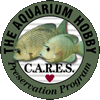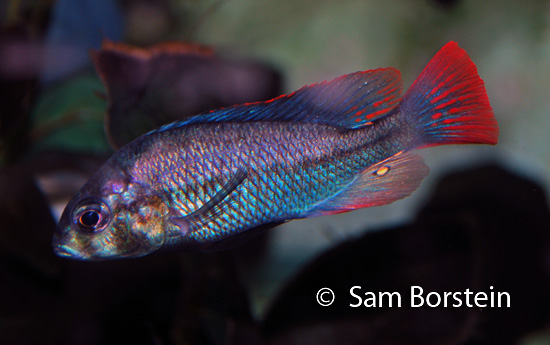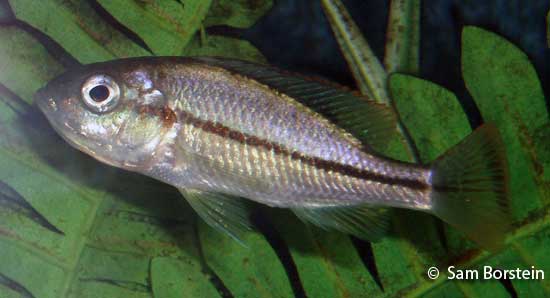Platytaeniodus sp. "red tail sheller'
Red Tail Sheller
Synonyms: Haplochromis sp. "blue neon", Haplochromis sp. "red tail sheller"


Above: A male Platytaeniodus sp. "red tail sheller". Photo by Sam Borstein.
Etymology:
Genus- Platy= flat (Greek), taenia= stripe (Latin), odus= teeth (Greek).
Species- "red tail sheller"= In reference to its feeding behavior as well as color.
Intro:
Playtaeniodus sp. "red tail sheller" is an undescribed Victorian cichlid. This species exhibits striking colors, especially when spawning. Females for this species even exhibit some amazing color in the fins. This fish is relatively new to the hobby and similar to a described species Playtaeniodus degeni. It is possible that Playtaeniodus sp. "red tail sheller" is in fact a location variant of Playtaeniodus degeni.
Distribution:
This fish is found at Hippo Point in Lake Victoria.
Size, Maturity, and Sexual Dimorphism:
Size: Males- 5 inches, Females- 4 inches
Maturity: 1 inch
Sexual Dimorphism: Males are larger than females and are a lot more colorful than the females. Females do obtain some nice red coloration in the fins.

Above: A mouthbrooding female Platytaeniodus sp. "red tail sheller". Photo by Sam Borstein.
Care:
I found this fish to be non-aggressive. They really only showed aggression while spawning, and even then it was minimal. A group of these can easily be kept with a mild Malawian, Tanganyikans, or West Africans in a 40 breeder.
Diet:
As the name implies, this fish eat snails by extracting them from the shell. I've not seen them do this to snails in my tanks (to bad, I hate trumpet snails). Greg Steeves, a well known Victorian cichlid hobbyist did say he noticed dip in his snail population when he added them to his tank. In captivity they will eat anything. A mix of various flake food and pellets mixed with occasional feedings of frozen food will be great for this fish.
Breeding:
I got a group of Red Tail Shellers from a local pet shop that were sold under the common trade name Haplochromis sp. "blue neon". They were about 1.5 inches at the time and there was a male in full color. I bought him, a sub-dominant male and 3 females. The bred about 4 days after I brought them home.
Breeding is done in typical Haplochromis fashion. The male excavated a pit and a few days before spawning and defended it from other males. The females were good holders. The eggs were small and not numerous, only 6-12 per spawn. It can be tough to tell when females are holding in this species as the buccal cavity doesn't distend very far. The best way to tell is to watch the behavior of the fish and see if it is "chewing". I stripped the fish after 16 days and the fry were free swimming.
Although small, the fry were not problematic to raise and grew fast. By 1 month they were an inch in length and males were starting to develop color.
Conclusion:
I really like this fish. They were peaceful and colorful. They were easy to breed and easy to keep. It can be hard to find this fish and it should be considered a hobbyist fish, which is a shame because it is a really nice species to keep.
